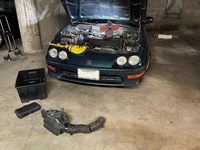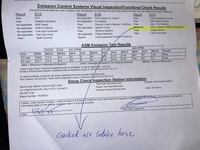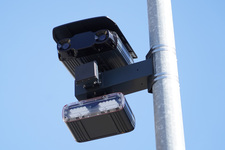 |
| Angelika/Mike Schilli |
|
Michael I have often expressed in this publication that there is no equivalent to the German TÜV (Technical Inspection Association) in America. Some states really allow any vehicle on four wheels to drive on the highways, but California tends to overregulate in this area as well. Every registered motor vehicle must pass the so-called smog test every two years (older vehicles even every year).
Recently, I learned firsthand that the smog test not only evaluates the exhaust gases escaping from the tailpipe. The inspector also goes through a checklist with at most a peripheral connection to the car's emissions. For example, the gas cap must seal airtight; if it doesn't, the onboard computer will display an error message, and the emissions inspector will refuse to give the stamp.
Recently, it happened to me when I cheerfully drove our aging Acura Integra, affectionately called "Rocket," to the smog center and, to my great astonishment, learned that our car had failed the smog test. I knew that in California, you can't continue to register a car without passing the smog test, and a slight unease set in. However, I found out that our Rocket hadn't exceeded the permissible emission levels; instead, a manual inspection of the engine compartment by the smog technician had discovered a crack in the hose to the air filter.
Such a small flaw should, of course, be fixed sooner than later, even with a 27-year-old car with 300,000 kilometers on the clock, because otherwise, the engine will suck in dust particles instead of filtered air, and ruin its interior. But honestly, I was surprised to learn that the smog inspector has TÜV-like authority when it comes to identifying defects. Anyway, I set about repairing the hose and, to my utter astonishment, also discovered that the spare part was no longer available by the manufaturer or 3rd party providers, and was only sporadically traded on eBay at astronomical prices, even as a pre-owned part.
Now, one must know that Japanese cars from the 1990s are still considered popular racing machines among young speedsters in San Francisco. Our model, an Acura Integra GSR, continues to enjoy lively interest in the "Fast and Furious" tuning scene. With only 170 horsepower, the vehicle, reminiscent of an Opel Manta, may not be exciting by today's standards, but it produces an infernal Formula One howl at 8000 revolutions per minute, just before the red zone begins. Smart cookie that I am, I ordered an intake manifold for race cars from a tuning parts supplier and installed it in place of the regular air filter.
That went relatively smoothly after I had to rearrange some hoses in the engine compartment due to space constraints, from which coolant aggressively gushed out when I unplugged them. Now we have a brand-new racing air filter in a 27-year-old engine. When I went to the smog guy for the (free) retest, all the emission values were again within legal limits, and he waved me through. I had made sure to buy a $200 filter that had the California certification (CARB). The part would have only cost $50 in other states. Thank you, California!
Recently, when I went to get an oil change, the mechanic immediately waved his colleagues over to show them the new part in the engine compartment. And our car now sounds normal when idling, but at higher speeds, it makes a noise that makes other drivers immediately take notice and respectfully move to the right lanes. That's how it should be. It's funny what unexpected side effects government overregulation can produce.














